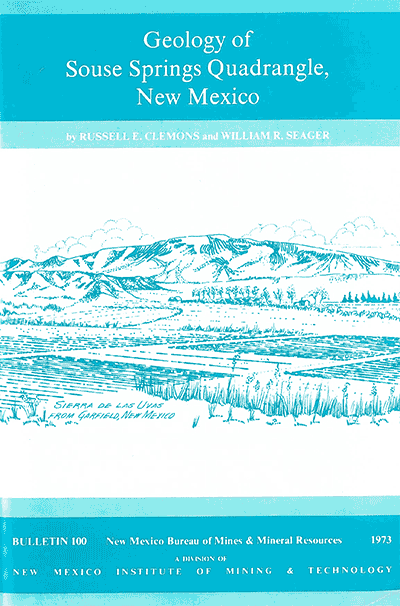
Bulletin 100 — Geology of Souse Springs Quadrangle, New Mexico
By R. E. Clemons and W. R. Seager, 1973, 31 pp., 6 figs., 7 appendices, 1 index, 1 sheet. Companion to Bulletins 97 and 101.

Establishes correlations of rock units of southern Caballo Mountains, Rincon Hills, and San Diego Mountain areas with rock units in the Sierra de Las Uvas. Provides information for mineral exploration, ground water and land-use studies, and general economic development. The Souse Springs 7½-min quadrangle in northwestern Doña Ana County, NM, includes the major part of the Sierra de Las Uvas. Broadly domed and faulted volcanic rocks and interbedded clastic sedimentary rocks of middle Tertiary age are unconformably overlain by late Tertiary and Quaternary clastic sedimentary rocks. Only along the eastern side of the quadrangle are older rocks exposed by uplift, westward tilting and erosion.
Oldest rocks exposed in the quadrangle are the upper part of the Palm Park Formation unconformably overlain by the Bell Top Formation, which is subdivided into six ash-flow tuff units, a basalt flow, and two sedimentary units. Flows of Uvas Basaltic Andesite interfinger with the upper sedimentary member. Thickness and number of flows in the Uvas decrease radially away from the crest of the Sierra de Las Uvas. The upper part of the Bell Top and the Uvas correlate with the lower half of the Thurman Formation to the northeast. Graben-fill fanglomerates and interbedded, reddish, basin-floor clastics, derived mainly from the Sierra de Las Uvas comprise the Rincon Valley Formation which unconformably overlies the Uvas flows. The Rincon Valley Formation is, in turn, unconformably overlain by the Camp Rice Formation. The Camp Rice is composed of fanglomerates, piedmont gravels, and finer basin facies, that overlap or grade in adjacent areas to fluvial sandstones deposited by the ancestral Rio Grande.
Several source areas for the Uvas Basaltic Andesite occurring in the quadrangle are located in complex, faulted grabens axial to the Sierra de Las Uvas Dome. Source areas for several members of the Bell Top were probably in the Cedar Hills, southeast of the quadrangle. Late Tertiary faulting uplifted the Sierra de Las Uvas range and resulted in tilting of the Uvas Dome to the northwest.
The Souse Springs quadrangle is located in northwestern Doña Ana County two miles south of Hatch. The Atcheson, Topeka, and Santa Fe Railroad from Hatch to Deming crosses the extreme northwest corner of the quadrangle. Water supplies are very limited and the rocky terrain supports a sparse cover of grass, cacti, and creosote bush. Few juniper trees exist at higher elevations. Principal use of the land is for grazing. The only place presently inhabited is the Las Uvas Ranch in the northwestern corner of the quadrangle. Light duty and unimproved dirt roads and jeep trails to scattered tanks and windmills provide access to most areas. The major part of the Sierra de Las Uvas occurs in the quadrangle, and also extends into the Sierra Alta, Corralitos Ranch, and Nutt quadrangles to the east, south, and west, respectively. Elevations within the quadrangle range from about 4,320 ft along the northwestern edge to 6,500 ft on Mesa Azur on the south central edge. Local relief of 700–1,000 ft is common in the canyons through the southern and eastern parts of the quadrangle.
$6.50
Buy
Now
Also available as a free download.
Download
| File Name | Size | Last Modified |
|---|---|---|
| B100.pdf | 9.20 MB | 01/15/2021 10:47:37 AM |
| GISdata: | ||
| GeMSVariationRedaMe.txt | 1 KB | 07/31/2019 12:31:59 PM |
| SouseSprings.mpk | 3.37 MB | 07/08/2019 12:58:55 PM |



